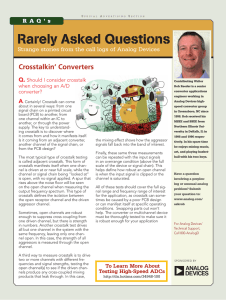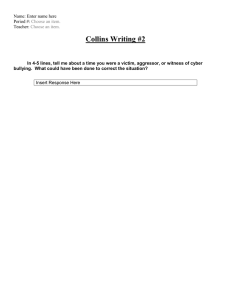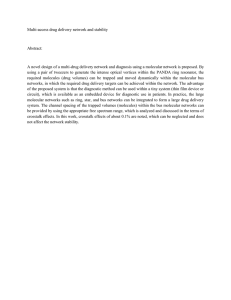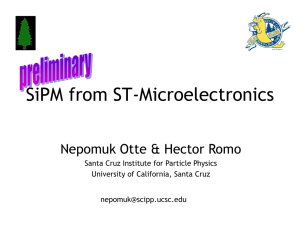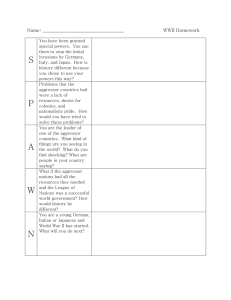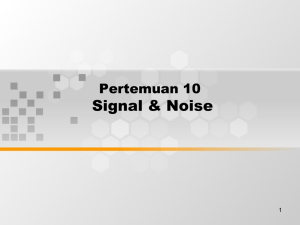Crosstalk, Part 1 Understanding Forward vs Backward
advertisement
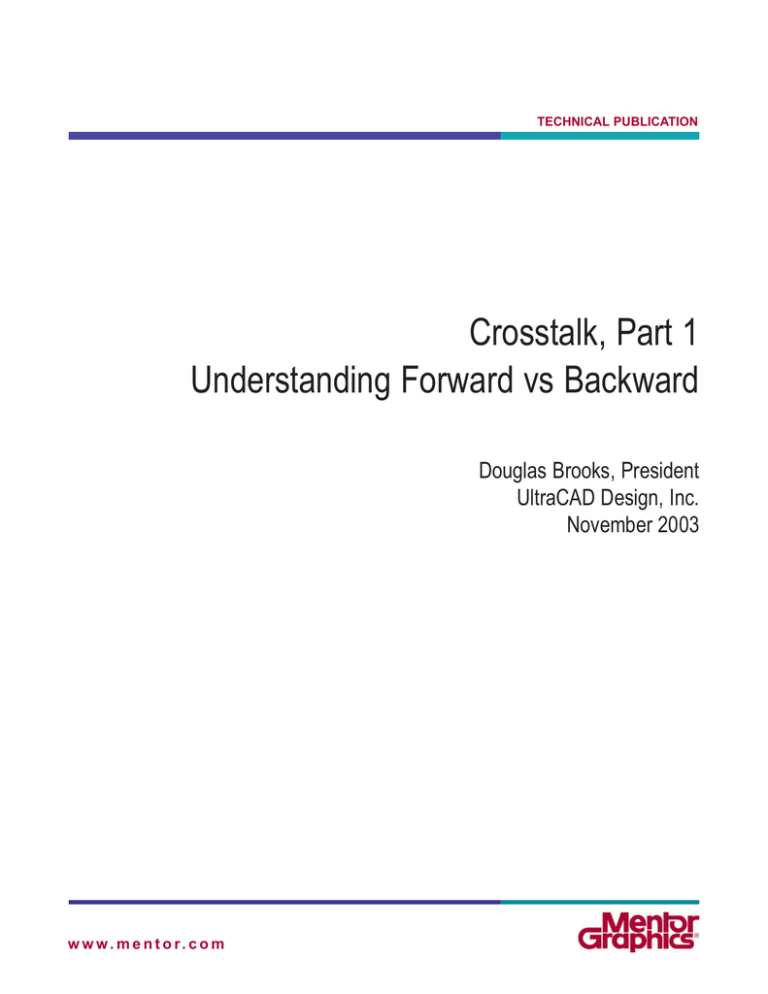
TECHNICAL PUBLICATION Crosstalk, Part 1 Understanding Forward vs Backward Douglas Brooks, President UltraCAD Design, Inc. November 2003 w w w. m e n t o r. c o m ABSTRACT Crosstalk can be a difficult phenomenon for PCB designers to grasp, particularly since there are two types of crosstalk, forward and backward, which behave quite differently. Although the magnitude of forward crosstalk increases as the length of the coupled region increases, its pulse width remains nearly constant and independent of the length of the coupled region. Backward crosstalk, on the other hand, has a nearly constant magnitude that is independent of the length of the coupled region (as long as the coupled region is "long enough"). But its pulse width is twice as long as the coupled region. This article is Part 1 of a three-part series on crosstalk. Crosstalk seems to be one of those concepts that confuses many PCB designers. It does have some subtle aspects to it, and it can be a serious problem in some designs. But even more serious, it has some very subtle effects that are hard to recognize. This article, and others to follow in this series, discuss these effects and is intended to help PCB designers understand this signal integrity problem. FORWARD VERSUS BACKWARD CROSSTALK Consider the case where we have two traces adjacent to each other (Figure 1). Current (the flow of electrons) flows down one of the traces (we call this trace the aggressor or driven line). That current will couple into the adjacent trace (called the victim line) and create two different noise signals. One of those noise signals will flow in the victim trace in the same (forward) direction as the aggressor current. The other noise signal will flow in the victim trace in the opposite (backward) direction. These two currents have different characteristics and degrees of importance in our circuits. Consider a current flowing down the driven line (in Figure 1) and consider an electron as it passes by the specific point X. Electrons are negatively charged particles. Since like charges repel each other, electrons at that point along the victim line will be "repelled" or will move away from point X. They will move in either direction (arrows labeled (3)), so there will be both a backward and a forward component to this reaction. This kind of coupling is almost exactly what we see in capacitors (electrons flowing onto one plate "repel" electrons from the other plate) so this is often referred to as capacitively coupled crosstalk. Figure 1: There are two causes of crosstalk, inductive and capacitive coupling, which lead to two types of crosstalk, forward and backward. Courtesy Prentice Hall.1 The current flowing in the direction of the arrow on the driven line will generate a magnetic field around the line. That field will intersect the victim line and induce (or generate) a current going the opposite direction in the victim line. This mechanism is exactly the same mechanism we find in transformers and in motors and generators.2 In fact, we can think of the driven and victim lines as being the primary and secondary windings of a poorly designed transformer. The induced current (2) always goes in a direction opposite that of the driven current. We call this induced current inductively coupled crosstalk. Note that both these mechanisms (capacitively and inductively coupled crosstalk) depend on the fact that the driven current is changing. No coupling occurs if no (or a constant DC) current is flowing. The faster the current is changing (i.e., the higher the frequency or the faster the rise time) the stronger the coupling between the traces. It also seems intuitive that the closer the traces are, the stronger the coupling will be. Already we have two secrets for reducing crosstalk (coupling): Slow down the signals and spread the traces further apart. (Wasn't that easy?) There is one other point worth noting here. Capacitively and inductively coupled crosstalk tend to reinforce themselves in the backward direction. Both create components flowing in the reverse direction. But they tend to cancel each other in the forward direction. Capacitively coupled crosstalk creates a forward component that flows in the same direction as the driven current, but inductively coupled crosstalk PAGE 1 moved well along the trace and by the last frame (Figure 2d) the signal has reached the far end of the trace. Figure 2: These are individual frames from an animation. They illustrate that forward crosstalk has a pulse width approximately equal to the rise time of the aggressor pulse with an amplitude that increases over the coupled length. Backward crosstalk has an approximately constant amplitude but increases in pulse width as the coupled length increases. flows in the opposite direction. These components almost exactly cancel, particularly in stripline environments. This intuitively leads to another design rule: If crosstalk is an issue, try to keep all the sensitive traces in a stripline environment, where the forward crosstalk components almost completely cancel each other out. There are significant differences in the nature of forward and backward crosstalk. Consider Figure 2. This figure consists of four individual frames of an animation. Although the text will describe verbally what is happening in the animation, you can see the actual animation itself by going to http://www.ultracad.com/seminar_ct_animation.htm. BACKWARD CROSSTALK Figure 2 consists of two rows, Row (1) and Row (2), with four frames each. Look first at Figure 2a, Row 1. The two rows of dots at the top represent elements of a victim trace. There are two rows because we are going to let the top one represent backward crosstalk and the other one represent forward crosstalk. The single row underneath them represents elements of the aggressor (driven) trace. There will be a signal, transversing from a low signal level to a high signal level, flowing from left to right along the aggressor trace. The two rows, 1 and 2, differ in that the victim trace in Row 2 is terminated in a high impedance at the near end. The victim trace in Row 1 extends indefinitely in the backward direction. In the first frame (Figure 2a), the aggressor signal is just starting down the trace. In the second frame (Figure 2b), the signal has started part way down the trace. In the third frame (Figure 2c), the signal has PAGE 2 Let's look first at backward crosstalk (top row of dots) for Row 1. Note how, as the driven signal moves down the aggressor trace, each time it passes by a victim element it kicks that element to the left. Each element, in turn, starts moving backward before the next element gets kicked. What results is a string of elements moving to the left (backward) stretching out in length. Especially note that by the time the aggressor pulse gets to the far end of the aggressor trace (d), the backward string of elements is twice as long as the coupled length between the victim and aggressor traces is. This happens because the first element starts moving at the same moment the aggressor trace starts moving. When the aggressor signal reaches the far end, the first element has moved equally far in the opposite direction. But the last element along the victim line doesn't even start to move backward until the aggressor signal reaches the far end. Thus the string of backward-flowing elements stretches twice as far as the length of the coupled region between the traces. There are two extremely important things to notice here. First, we are talking about time, not units of distance. It takes a certain amount of time for the aggressor signal to travel down the trace. We call this the propagation time of the signal traveling along the coupled region. Second, if we assume the signal flows at 6 inches per ns, and each circular element represents .25 ns, then the coupled region between the two traces is 2.5 ns, or 15 inches. The backward crosstalk signal stretches twice as far, or 5 ns. We can generalize this as follows: The backward crosstalk pulse is (almost) constant amplitude in magnitude but twice as wide as the propagation time represented by the coupled region. This backward crosstalk pulse width is what so many people have trouble understanding. The width is not a function of coupling strength. Width is purely a function of the length of the coupled region. The statement is worth repeating: The backward crosstalk pulse width is purely a function of the length of the coupled region. Now, the top row of dots for Row 2 shows exactly the same thing with one modification. The vertical line at the left of the victim trace represents the beginning of the trace. It might represent a driver or a load. As the first element of the backward crosstalk row gets kicked backward by the aggressor signal, it reflects off the end of the trace and begins flowing in the forward direction. This is not to be confused with forward crosstalk. It is simply a reflected backward crosstalk signal. (One obvious question is this: Could we eliminate this reflection if we correctly terminated this end of the victim trace using the transmission line termination principles? The answer is "Yes."3 ) In this case, the first element of the backward crosstalk signal reaches the forward end of the trace at the same time the aggressor signal does. But the last element on the victim trace has just started its travel in the reverse direction. Before the show is over, it must travel all the way back to the beginning of the trace, reflect off the beginning of the trace, and travel all the way back to the forward end again-a distance that takes twice as long as it took the aggressor pulse to travel the length of the coupled region. Again, we see that the backward crosstalk pulse width is twice as long as the propagation time down the coupled region. A word about the magnitude of the backward pulse: If the coupled region is short, the magnitude of the backward signal will be small. It will grow as the coupled length increases. But there is a limit to how high the magnitude will grow until it stops and just levels off. That limit in magnitude is reached when the coupled length is about equal to the so-called critical length we talk about with transmission lines. That is, the magnitude of the backward coupled pulse reaches its maximum about when the length of the coupled region equals one-half the rise time of the aggressor signal. This should be considered more as a rule of thumb than as a factual statement, but it is a rule that seems to hold true most of the time. What that maximum level actually is a different story altogether. I talk more about that in Part 2 of this series. In summary, backward crosstalk grows fairly quickly to a constant magnitude pulse whose pulse width is twice as wide as the propagation time down the coupled region. FORWARD CROSSTALK The second row of dots for each victim trace represents what happens with forward crosstalk. In Figure 2b Row 1 or Figure 2b Row 2, as the aggressor signal just starts to propagate along the trace, the first element in the forward crosstalk row is kicked forward. It immediately bumps into the next element. As the aggressor signal moves forward one more increment, the first two victim elements get kicked further along and bump into the third element. This continues as the aggressor keeps kicking the forward crosstalk elements along. By the time the aggressor signal reaches the end of its trace, the forward crosstalk elements are all bunched together at the far end of the victim trace. Note that the forward crosstalk illustration is exactly the same for Row 1 and Row 2. It does not matter whether the victim trace begins at the beginning of the coupled region or extends further back. Since the forward crosstalk signal never travels in the reverse direction, it doesn't care whether there is a reflecting barrier or not. The quantity of the forward elements represents the magnitude of the forward crosstalk signal. As suggested in Figure 2, the forward crosstalk signal will continue to increase in magnitude the longer is the coupled region. Although there is a theoretical limit to how high the forward crosstalk signal can grow, we are never likely to reach that limit on circuit boards (the coupled region can't be long enough). For our purposes, the forward crosstalk signal simply continues to grow larger and larger as the coupled region increases. There is one other distinctive thing about the forward crosstalk signal. All the elements representing the signal are clustered on top of each other. This represents the width of the forward crosstalk pulse. In theory, the width of the forward crosstalk pulse is no wider than the rise time of the aggressor signal that creates it. The pulse starts to build as the aggressor signal starts to rise, and it has finished building when the aggressor signal has reached its maximum value. VISUALIZATION Figure 3a and 3b illustrate a HyperLynx LineSim simulation of crosstalk. The simulated microstrip traces are 8 mil wide, separated by 5 mil, edge-toedge, and are either 66 or 132 inches (10 or 20 nanoseconds) long.4 The rise time of the aggressor signal is approximately 1.25 ns. The aggressor signal rises quickly (with a rise time of about 1.25 nsec) to about 4.4 volts. Ten or 20 nsec later the forward and backward crosstalk signals arrive at the far end of the victim trace. The backward crosstalk pulse is about 333 mV in either simulation. Its magnitude is independent of the length of the coupled region. But the backward crosstalk pulse width is about 20 nsec in PAGE 3 Figure 3a and about 40 nsec in Figure 3b, twice the length of the coupled region in each of the simulations. the fall time) of the aggressor signal. The forward crosstalk pulse is about -1.4 Volts in Figure 3a and about -2.0 Volts in Figure 3b. But the pulse is the same width in each simulation. 1. Brooks, Douglas, Signal Integrity Issues and Printed Circuit Board Design, Prentice Hall, 2003, p. 222. 2. Brooks, ibid., Appendix B, "Why Inductors Induct." 3. See discussion in Part 2 of this series. 4. This is obviously a poor design from a crosstalk standpoint. The reason why the simulation is set up this way will be explained more fully in Part 3 of this series. SUMMARY These HyperLynx simulations illustrate that the backward crosstalk signal is relatively constant in magnitude and has a pulse width twice as wide as the propagation time down the coupled region, but the forward crosstalk signal has an amplitude that continually increases as the coupled region increases and has a fixed pulse width equal to the rise time (or FOOTNOTES ABOUT THE AUTHOR Douglas Brooks has a BS and an MS in Electrical Engineering from Stanford University and a PhD from the University of Washington. During his career has held positions in engineering, marketing, and general management with such companies as Hughes Aircraft, Texas Instruments and ELDEC. Brooks has owned his own manufacturing company and he formed UltraCAD Design Inc. in 1992. UltraCAD is a service bureau in Bellevue, WA, that specializes in large, complex, high density, high speed designs, primarily in the video and data processing industries. Brooks has written numerous articles through the years, including articles and a column for Printed Circuit Design magazine, and has been a frequent seminar leader at PCB Design Conferences. His primary objective in his speaking and writing has been to make complex issues easily understandable to those without a technical background. You can visit his web page at http://www.ultracad.com and e-mail him at doug@eskimo.com. Figure 3:In these HyperLynx crosstalk simulations, the coupled region is twice as long in (b, bottom) as it is in (a, top). The impact of the length of the coupled region is different on the forward crosstalk signal (negatively going pulse) that it is on the backward crosstalk signal (the positive pulse following the backward crosstalk signal.) PAGE 4
